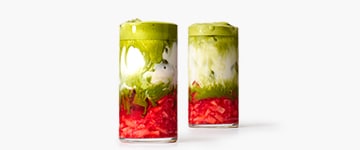Published February 8, 2023
There is a lot of confusion around sugar content. For instance, not all sugars need to be limited—just added sugars. There is a difference between added and naturally occurring sugars. Using artificial sweeteners is a way to cut back on added sugar intake, and they can be consumed in moderation as part of a balanced diet.

Added sugars and naturally occurring sugars.
You may be trying to limit your sugar intake, especially added sugars, because of concerns about weight gain or your risk of heart disease or type 2 diabetes.1
Added sugar refers to any type of sugar or sweetener that is added to foods or beverages during preparation or processing. Even though some sugars are perceived as a “natural” or a “healthier choice” such as maple syrup, coconut sugar, turbinado sugar, honey, and agave, these are still added sugars. These sweeteners have about the same number of calories and are counted as added sugars. Naturally occurring sugars are found in foods like fruit (as fructose) or milk (as lactose).
How much added sugar is recommended?
The 2020–2025 Dietary Guidelines for Americans recommends that Americans 2 years and older keep their intake of added sugars to less than 10% of their total daily calories. For example, in a 2,000–calorie diet, no more than 200 calories should come from added sugars (about 12 teaspoons). Children younger than 2 years should not be fed foods and beverages with added sugars at all.2
The facts about alternative sweeteners.
Alternative sweeteners are often referred to as sugar substitutes, high-intensity sweeteners, nonnutritive sweeteners, or simply low-calorie sweeteners. These sweeteners are popular but somewhat controversial. But the fact is that these sugar substitutes have been extensively studied, and overall, there is no conclusive evidence for beneficial or harmful effects on health outcomes, including appetite and short-term food intake, risk of cancer, risk of diabetes, risk of dental cavities, weight gain, or the risk of obesity.3
Replacing sugary foods and drinks with options containing alternative sweeteners is one way to limit calories from added sugars. Let’s discuss some of the types of sweeteners and where you can find them in foods. There are seven noncaloric sweeteners currently approved for use in the United States: acesulfame K, aspartame, monk fruit (luo han guo) extract, neotame, saccharin, stevia, and sucralose.4
Aspartame.
Aspartame is found in many products including carbonated soft drinks, chewing gum, gelatin, dessert mixes, puddings, desserts, yogurt, vitamins, and sugar-free cough drops. As a tabletop sweetener, aspartame is sold under the brand name Equal. Aspartame is one of the most controversial sweeteners as it has been linked with cancer, but these claims are unfounded.5
Acesulfame potassium.
Acesulfame potassium, also known as acesulfame K and Ace-K, is approximately 200 times sweeter than sucrose. It has a sweet, clean taste that doesn’t linger or leave an aftertaste. It is often combined with sucralose in energy drinks.6
Sucralose
Sucralose (Splenda) is more suitable for baking than other artificial sweeteners because it retains its sweetness despite the changes in temperature associated with baking. Aspartame and Equal lose their sweetness when heated. Sucralose is available as an ingredient for use under the brand name Splenda. Currently, a range of products sweetened with Splenda are on supermarket shelves, such as carbonated soft drinks, low-calorie fruit drinks, maple syrup, and applesauce. Sucralose is also available in two forms—granular and packets. The granular tabletop sweetener can be used as a spoon-for-spoon replacement for sugar in baking, while some other sweeteners cannot. The convenient packet form can be used to sweeten beverages and to sprinkle on cereal or fruit.7
Stevia.
Stevia is obtained from a plant and is perceived as a natural sweetener although it is synthetically derived. The sweet-tasting components of the stevia plant are called steviol glycosides. Steviol glycosides are isolated and purified from the leaves of the stevia plant and are added to some foods, beverages, and tabletop sweeteners.8
Monk fruit.
Monk fruit (or lo han guo) is extracted from fruit grown in the valleys and foothills of sub-tropical Asia.9 Monk fruit sweeteners are either in liquid or powdered form and are used in a wide range of foods and beverages like soft drinks, juices, dairy products, desserts, candies, and condiments.10 Curious? Try our Publix Aprons® Strawberry Matcha Breeze, which uses monk fruit so it has no added sugars.
Allulose.
Allulose is a newcomer to the sweetener scene and is available in granulated and liquid forms as a tabletop sweetener. It occurs naturally in wheat and some fruits and is commercially produced from corn. Allulose does contain calories, but according to the Food and Drug Association (FDA), it does not have to be listed under total sugars or added sugars on nutrition facts panels. It must be labeled as a carbohydrate since it is technically classified as such. When people consume products with allulose, the body absorbs it but does not metabolize it. Unlike other caloric sugars, allulose has no impact on blood glucose or insulin levels. Research is only beginning to show the potential benefits of allulose, so stay tuned.11
Sugar alcohols.
Sugar alcohols, or polyols, are a type of carbohydrate that are not absorbed or digested completely. They have fewer calories than sugar and some are calorie–free. Sugar alcohols end in -ol and include erythritol, maltitol, sorbitol, and xylitol. These ingredients may be found in a wide range of products, including chewing gums, sugar-free candies, ice cream, baked goods, and fruit spreads. They are also used in toothpastes, mouthwashes, breath mints, and pharmaceuticals such as cough syrups or drops and throat lozenges.12 Try our Aprons Almond Latte Tiramisu, made with erythritol. Be aware that many sugar alcohols can cause gas, bloating, and other gastrointestinal issues, especially when eaten in large amounts, and some people may be more sensitive to this effect than others.13
The bottom line on sugars.
Alternative sweeteners, when consumed in moderation, are a strategy to reduce added sugars in the diet and can be part of a balanced eating pattern.
For the love of you.
Choosing how you eat is uniquely personal. It’s about your needs, your preferences, and your goals. As your wellness ally, we’re in your corner with fresh ideas, recipes, and wellness icons that make it easier to shift toward wiser food choices. It’s all about you, at your very best.
Sources
1 U.S. Department of Health & Human Services (HHS). Get the Facts: Added Sugars. Centers for Disease Control and Prevention (CDC). November 28, 2021.
2 U.S. Department of Agriculture & U.S. Department of Health and Human Services. Dietary Guidelines for Americans, 2020–2025, 9th ed. December 2020. Available at DietaryGuidelines.gov.
3 Lohner, Szimonetta, Ingrid Toews, and Joerg J. Meerpohl. Health outcomes of non-nutritive sweeteners: analysis of the research landscape. Nutrition Journal 16, no. 1 (September 8, 2017): 55.
4 Additional Information about High-Intensity Sweeteners Permitted for Use in Food in the United States. U.S. Food & Drug Administration (FDA). February 8, 2018.
5 Does Aspartame Cause Cancer? American Cancer Society. February 11, 2019.
6 Acesulfame K. Calorie Control Council. Accessed October 19, 2022.
7 Sucralose. Calorie Control Council. Accessed October 19, 2022.
8 Stevia. Calorie Control Council. Accessed January 31, 2023.
9 Monk Fruit. Calorie Control Council. Accessed October 19, 2022.
10 Everything You Need To Know About Monk Fruit Sweeteners. FoodInsight.org. October 27, 2021.
11 Sollid, Kris, RD. What Is Allulose? FoodInsight.org. December 15, 2021.
12 Polyols. Calorie Control Council. Accessed October 19, 2022.
13 Ross, Tami A., RDN, LD, CDE. What Are Sugar Alcohols? American Diabetes Association. September 2019.

 You are about to leave publix.com and enter the Instacart site that they operate and control. Publix’s delivery and curbside pickup item prices are higher than item prices in physical store locations. Prices are based on data collected in store and are subject to delays and errors. Fees, tips & taxes may apply. Subject to terms & availability. Publix Liquors orders cannot be combined with grocery delivery. Drink Responsibly. Be 21. For prescription delivery, log in to your pharmacy account by using the Publix Pharmacy app or visiting
You are about to leave publix.com and enter the Instacart site that they operate and control. Publix’s delivery and curbside pickup item prices are higher than item prices in physical store locations. Prices are based on data collected in store and are subject to delays and errors. Fees, tips & taxes may apply. Subject to terms & availability. Publix Liquors orders cannot be combined with grocery delivery. Drink Responsibly. Be 21. For prescription delivery, log in to your pharmacy account by using the Publix Pharmacy app or visiting 
